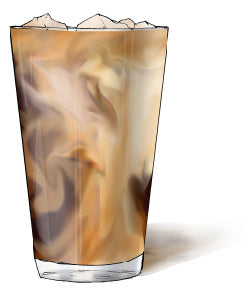HOW TO BREW THE PERFECT COLD BREW COFFEE
Splashing onto your palate on a hot summer day, cold brew’s uniquely rich flavor imbues its transporting qualities into your body – taking you away, sans plane ticket, to a place enlivened with color and activity. It’s the busiest Moroccan street market, brimming with activity and tiny surprises at every corner, while never failing to delight.
Though long thought of as a novelty iced coffee, cold brew has emerged as the destination iced coffee in recent years, blossoming into a summer pick-me-up that not only holds its own, but stands tall as the go-to for those simmering summer days.
Why? That’s easy: You don’t really need milk to enhance its flavor – or much ice, for that matter.
Though long thought of as a novelty iced coffee, cold brew has emerged as the destination iced coffee in recent years, blossoming into a summer pick-me-up that not only holds its own, but stands tall as the go-to for those simmering summer days.
Why? That’s easy: You don’t really need milk to enhance its flavor – or much ice, for that matter.
About Cold-Brew Coffee:
Cold brew coffee boasts a consistency that coffee poured over ice does not. Because it’s steeped for such a long period of time (up to 24 hours), its flavor is defined by coarse grinds’ exposure to cold water and the length of exposure, more so than the blend of the coffee itself. (Note: No, that doesn’t mean you should use low-quality grinds – but maybe repurpose some leftover coffee that has an older roasting date.) As a result, your coffee will almost always boast variations of a chocolate-caramel quality, defined by its smooth texture and heavier punch than standard iced coffee – made better by the fact that it’s brewed cold, so melted ice won’t dilute your coffee. That’s also a big part of why you might feel a heavier caffeine punch.
Without further ado, here’s your go-to guide for properly making this summer’s best cold brew.

-
Prepare your work area by gathering your preferred container (ideally glass, with a lid), lining it with the mesh bag and measuring out your coffee beans for grinding.
You’ll want a medium or dark roast coffee to highlight the natural smoothness and sweetness of the cold brew; how much coffee you measure out will depend on whether you’re aiming for a big batch or just a few glasses, but for this purpose, let’s use a full cup of coffee grinds. -
Measure out four cups of ice-cold, filtered water.
Important to know: This particular ratio of coffee to water will create cold-brew concentrate, which means you’ll want to cut your concentrate with equal parts water upon pouring. This way, you not only get a better-preserved coffee, but a more versatile one (if you want to toy around with adding milk and syrups), as well as a smaller footprint in your refrigerator. So, in reality, know that you’re adding four cups of water but really getting eight cups’ worth of actual cold-brew iced coffee. -
Grind your coffee on the coarsest setting.
This is best for the long brew time, but also practical for ensuring there aren’t fine grinds lingering in your coffee. -
Now, it’s time to both pour and turn the coffee grinds into what we’ll lovingly call a “dumpling.”
Scoop the coffee into a paper coffee filter, and put it inside the mesh at the bottom of the container.
Pour two cups of water over the dumpling, and let it soak. After about 30 seconds, tie the coffee filter together – grinds inside – with a string, before pouring the rest of the cold water on top of the dumpling. This double-layer of filters will ensure there aren’t coffee grinds in your final product. -
Seal the container with a lid, and let the coffee steep – think of it like tea-brewing -- at room temperature for approximately 18 to 24 hours.
Be sure that the container is well-sealed and out of sunlight to prevent mold from accumulating over time. -
After enough time has elapsed,
toss the dumpling and remove the mesh bag.
Remember to wash the bag before doing this process again. -
Cut your concentrate with equal parts water, pour some ice and enjoy!
Your concentrate should last for about two weeks when refrigerated – though, for peak freshness, you’ll want to consume it within a week. Like any coffee, its flavor profile degrades over time.
Ways to Spruce Up Your Cold-Brew Experience
Cold brew is, aside from being a sweet-tooth-satisfying beverage on its own, even more satisfying when dressed up with some lightly sweet added flavors. In body and taste, the result is often like having a latte, only without having to steam the milk. We’ll name a few recipes in detail below, but don’t be afraid to experiment with a variety of vanilla, coconut, chocolate and floral flavors on your own.Vanilla Almond Cold Brew
- ½ cup of cold brew concentrate
- Three drops of vanilla extract or, if you prefer, just enough vanilla syrup to coat the bottom of the glass
- Almond milk to taste, or until about 2/3 of your glass is filled
- A pinch of cinnamon
Cinnamon Orange Coffee
- ½ cup of cold brew concentrate
- 1 orange wedge (or a bottom-of-glass coating of orange syrup)
- Warm cinnamon sticks
- Pinch of cinnamon
- Pinch of coconut sugar
Lavender Cold Brew
- ½ cup of cold brew concentrate
- Milk of your choice to taste, or about ½ cup for precision
- Enough lavender simple syrup to coat the bottom of the glass. To make the syrup, combine a teaspoon of lavender flowers, ½ cup of sugar and ½ a cup of water and simmer
- Honey to taste
For a limited time - Take 50% off of your first shipment of amazing single origin, specialty grade coffee from around the world.